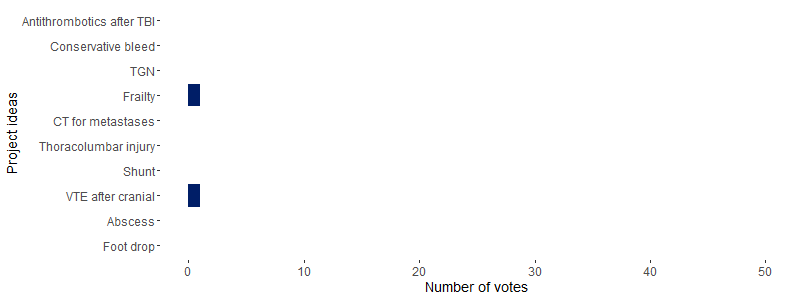Project ideas selected to progress
Timing of surgery in foot drop secondary to lumbar degenerative disease: when do we intervene?
P: Adults (aged ≥ 18) with foot drop (MRC ≤ 3 in ankle dorsiflexion) treated at spinal units (neurosurgical/orthopaedic) in the United Kingdom. I: Lumbar decompression performed within 7 days of onset of foot drop for degenerative pathologies. C: Decompression performed after 7 days of onset. Secondary comparison will be with those managed non-operatively. O: Recovery of foot drop, defined as MRC ≥ 4 in ankle dorsiflexion, at 3- to 6-month follow-up.
Advice on re-initiating anti-coagulants/anti-platelets post traumatic haemorrhage
P: Patients over 65 on anticoagulants/antiplatelets with conservatively managed traumatic intracranial haemorrhage. I: development of scoring matrix to help standardise and guide advice on restarting anticoagulants/antiplatelets, incl advice on the need for re-imaging. C: Unit/consultant based led decision, that are typically based on anecdotal experience, compared to evidence based and standardised guidelines. O: Consistency and confidence in evidence based advice, which is standardised across the country.

A total of 102 votes were cast in the voting week. "Timing of surgery in foot drop secondary to lumbar degenerative disease: when do we intervene?" submitted by Nithish Jayakumar (Newcastle) received 46 votes and "Advice on re-initiating anti-coagulants/anti-platelets post traumatic haemorrhage" submitted by Helen Ota (Imperial) received 39 votes. These themes will proceed to the next stage of project selection. We thank those who submitted an idea to this year's project call.
Project call 2021
We are delighted to announce our next round of project call. The format of our project call has changed to encourage greater participation across the country. Please sign up for the mailing list to receive updates on the process. Below is a short video outlining the key information.
Project selection
-
All members of the BNTRC (neurosurgical trainees and staff grade / SAS doctors) can submit an idea to the BNTRC. A research idea consists of a provisional title and a short description in PICO/PECO format. Descriptions should be brief (150 characters for each PICO component).
-
Once ideas have been submitted, the BNTRC will present the ideas anonymously to neurosurgical trainees, staff grades, SAS doctors, and consultants. These stakeholders can vote for up to two project ideas.
-
The top two project ideas will be selected as project themes.
-
Two study design hackathons / workshops discussing the selected project themes will take place. BNTRC committee members will lead these sessions aiming to discuss these themes collaboratively and share experiences from our clinical practice and collaborative research. Attendance to at least one of these workshops is mandatory if you would like to apply to become a project lead. Please save the dates for 20th and/or 27th of October (Wed) 7:30-9:00pm.
Study team selection
-
Those who are interested in being a member of the steering committee should submit an application to the BNTRC. There are two main types of application:
-
Study co-leads
-
Study team members
-
-
For those who would like to be considered for study co-leads, please submit a 500-word statement about how you would design your study (~350 words) and how you would work to increase inclusivity and engagement among trainees (~150 words). It is recommended that the former part of the application follows the structure of a study proposal abstract. The scoring matrix is available in the information pack.
-
For those interested in being a study team member, please submit a 500-word statement outlining the skills that you can bring to the study team and how being a part of the study team will help you. Specific roles in the steering committee are available in the PDF document. There is no scoring matrix as these applications will be considered by the selected co-leads anonymously. It will be up to the co-leads to choose.
-
Each co-lead application will be scored by a BNTRC committee member and a consultant colleague who has supported a BNTRC project. The combined score will be used for ranking applications. There is no formal mechanism for providing feedback at present, but applicants can request feedback by contacting the BNTRC.
-
The two top-scoring applicants from different neurosurgical units will be selected as study co-leads. They will be asked to confirm their availability for this role and to confirm whether they would like to work with each other. In the event of one or both applicants declining the role, the next top-scoring applicant will be invited in an iterative process.
-
The two co-leads will then review applications for study team members anonymously to identify trainee members of the steering committee.
-
Further information about the steering committee structure is available in the PDF document.
Contact
Please contact Michael (michael.poon@ed.ac.uk) if you have any queries.

